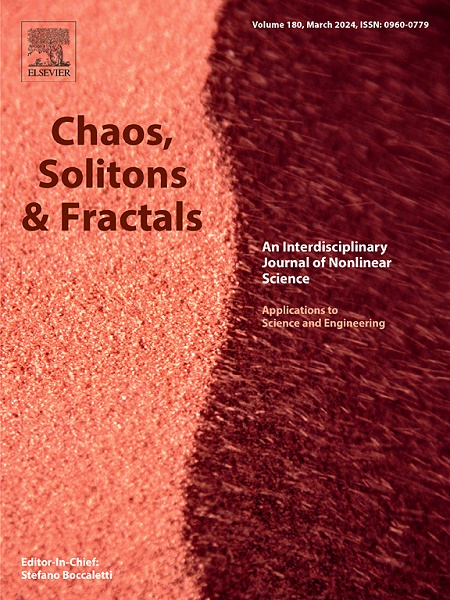Enhanced second-order sideband generation and slow–fast light via coupled opto- and magnomechanical microspheres
IF 5.6
1区 数学
Q1 MATHEMATICS, INTERDISCIPLINARY APPLICATIONS
引用次数: 0
Abstract
In this research, we investigate second-order sideband generation (SSG) and slow–fast light switching using a hybrid system comprised of two coupled opto- and magnomechanical microspheres, namely a YIG sphere and a silica sphere. The YIG sphere hosts a magnon mode and a vibration mode induced by magnetostriction, whereas the silica sphere has an optical whispering gallery mode and a mechanical mode coupled via optomechanical interaction. The mechanical modes of both spheres are close in frequency and are coherently coupled by direct physical contact between the microspheres. We use a perturbation approach to solve the Heisenberg–Langevin equations, offering an analytical framework for transmission rate and SSG. We demonstrate that the transmission rate and SSG are strongly dependent on the magnomechanical, optomechanical, and mechanical–mechanical coupling strengths (MMCS) between the two microspheres. The numerical results show that increasing the MMCS can enhance both the transmission rate and SSG efficiency, resulting in a gain within our system. Our findings, in particular, reveal that the efficiency of the SSG can be effectively controlled by cavity detuning, decay rate, and pump power. Notably, our findings suggest that modifying the system parameters can alter the group delay, thereby regulating the transition between fast and slow light propagation, and vice versa. Our protocol provides guidelines for manipulating nonlinear optical properties and controlling light propagation, with applications including optical switching, information storage, and precise measurement of weak signals.
通过耦合光-磁微球增强二阶边带生成和慢速光
在这项研究中,我们研究了二阶边带生成(SSG)和慢速光开关,使用由两个耦合的光和磁微球组成的混合系统,即YIG球和二氧化硅球。YIG球具有磁致伸缩诱导的磁振子模式和振动模式,而二氧化硅球具有光窃窃廊模式和通过光-力相互作用耦合的机械模式。两种微球的力学模式频率相近,并通过微球之间的直接物理接触进行相干耦合。我们使用微扰方法求解海森堡-朗格万方程,提供了传输速率和SSG的分析框架。我们证明了传输速率和SSG强烈依赖于两个微球之间的磁力学、光力学和机械-机械耦合强度(MMCS)。数值结果表明,增加MMCS可以提高传输速率和SSG效率,从而在系统内获得增益。我们的研究结果特别表明,SSG的效率可以通过腔失谐、衰减率和泵浦功率有效地控制。值得注意的是,我们的研究结果表明,修改系统参数可以改变群延迟,从而调节快慢光传播之间的转换,反之亦然。我们的协议为操纵非线性光学特性和光传播的控制提供了指导,应用包括光开关,信息存储和微弱信号的精确测量。
本文章由计算机程序翻译,如有差异,请以英文原文为准。
求助全文
约1分钟内获得全文
求助全文
来源期刊

Chaos Solitons & Fractals
物理-数学跨学科应用
CiteScore
13.20
自引率
10.30%
发文量
1087
审稿时长
9 months
期刊介绍:
Chaos, Solitons & Fractals strives to establish itself as a premier journal in the interdisciplinary realm of Nonlinear Science, Non-equilibrium, and Complex Phenomena. It welcomes submissions covering a broad spectrum of topics within this field, including dynamics, non-equilibrium processes in physics, chemistry, and geophysics, complex matter and networks, mathematical models, computational biology, applications to quantum and mesoscopic phenomena, fluctuations and random processes, self-organization, and social phenomena.
 求助内容:
求助内容: 应助结果提醒方式:
应助结果提醒方式:


